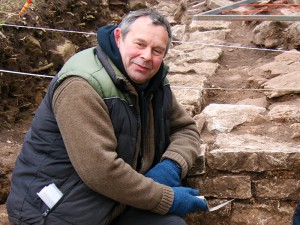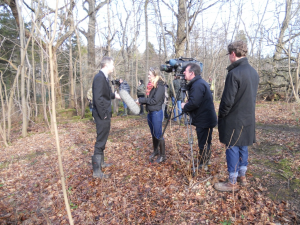Another long day in the office and it’s time to log off and drive home. But it’s not always like this. As an Environmental Advisor for the Defence Infrastructure Organisation (DIO) I could just as likely be perusing a prehistoric burial mound on Stanford Training Area or browsing the Blue Streak missile sites on RAF Spadeadam. As you might have guessed, my area of expertise is Archaeology, and I have been working in this field for more years than I care to remember.

After serving time on a Roman fort at Castleford in West Yorkshire for 10 years and then a spot of private consultancy in Barnard Castle, County Durham for another decade, I had the massive good fortune to land a job at the Ministry of Defence (MOD).
To be honest, and I suspect like many people, my initial thoughts were what on earth have MOD and archaeology got in common? Would it not be optimism bordering on lunacy to think that fragile archaeological remains could survive on military sites?
How wrong I was. Not only does archaeology survive, but it thrives, in what some might think is the most hostile environment in the country.
Let me explain further. Of all the estates owned by the government, the MOD estate is the biggest. It has something like 1,000 listed buildings, 730 scheduled monuments, several world heritage sites, historic battlefields and thousands of other non-designated sites.

MOD is not exempt from the laws which protect our cultural heritage. A failure to protect these sites could contravene legislation and planning policy, as well as inviting criticism from press, politicians and private citizens. Management of these sites is both best policy and best practice.
A good example is the site of Covenanters Wood at Dreghorn Barracks on the outskirts of Edinburgh, which a member of the local community recently brought to my attention. The site does not fall within the barracks’ security fence and is used as a leisure amenity by civilians - think dog walking.
One local resident mentioned to the press that, as a child, she remembers her father taking her to the woods and showing her the trenches in which he trained before being sent to the Western Front during the First World War.
Remarkably, these practice trenches still survive in the woodland and are in pretty good condition. With the help of the City of Edinburgh Council and various other organisations, DIO has commissioned a survey of the trenches and we hope to produce interpretation panels and educational material to bring this historic site to life for future generations.

A small example perhaps, but without a co-ordinated approach to the site by DIO colleagues and external bodies, and bearing in mind the commemoration of WW1 in 2014, it could have put DIO in the spotlight - for all the wrong reasons.
MOD does a good job training servicemen and women for their various roles. This is done on large training areas such as Otterburn, Catterick and Salisbury Plain, on naval bases and on RAF sites. But, as I have learned in my 10 years in post, there is much more to MOD than meets the eye. My work allows DIO to meet our statutory obligations whilst discovering archaeological gems from our nation’s past.
2 comments
Comment by Chris Wilson posted on
Hi I understand that Phil Abramson is now responsible for Warcop Cumbria It it be possible to contact me. e:mail [removed by admin] . com many thanks Chris Wilson
Comment by DIO Communications Team posted on
We'll pass that on Chris.